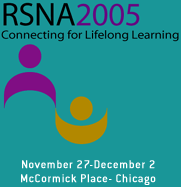
Abstract Archives of the RSNA, 2005
Feng Feng MD, Presenter: Nothing to Disclose
Xiao-zhen Li MD, Abstract Co-Author: Nothing to Disclose
Jing Wei MD, Abstract Co-Author: Nothing to Disclose
Wei Zhou MD, Abstract Co-Author: Nothing to Disclose
Fei Sun, Abstract Co-Author: Nothing to Disclose
ZhengYu Jin, Abstract Co-Author: Nothing to Disclose
To investigate possible neurochemical alterations in patients with SARS-related (severe acute respiratory syndrome, SARS) posttraumatic stress disorder (PTSD) using proton magnetic resonance spectroscopy.
Single voxel 1H-MRS was performed at a 3-Tesla MR scanner in 19 patients with SARS-related PTSD (M:F=7:12, mean age=45.42±10.33), and 19 age- and sex-matched healthy controls (M:F=7:12, mean age=46.42±10.24). The patients met the modified DSM-IV criteria for PTSD, and were medication-free over one year. 1H-MRS was acquired by routine Probe-P sequence (TR1500ms, TE35ms, NEX=8, NAV=128). Voxel (8cc) was placed in the anterior cingulate cortex, left prefrontal white matter, left parietal white matter, and posterior cingulate cortex by an experienced radiologist. Neurochemicals like N-acetylaspartate (NAA), choline-containing compounds (Cho), myo-insositol (mI) were estimated by their respective ratios to total creatine (Cr). Glutamate (Glu) and unresolved glutamate and glutamine (Glx) were acquired by PRESS-J sequence (TE-averaged PRESS, TR=1500ms, NEX=4, NAV=64) and their respective ratios to Cr were calculated by spectral analysis software (SAGE7.4). Statistical analysis was using SPSS package (Version 13.0 for windows). Spectroscopic data were analyzed by two-tailed Student T test for paired samples.
The ratio of NAA to Cr at anterior cingulated cortex was significantly lower in SARS-related PTSD patients than that in healthy controls (paired t=2.391, P=0.0280.05). Other ratios like Cho/Cr, mI/Cr, Glu/Cr, Glx/Cr in either location weren’t significant different from those in the control group.
Decreased NAA/Cr ratio in patients with SARS-related PTSD suggests that anterior cingulated cortex may be involved in the pathogenesis of SARS-related PTSD.
Feng, F,
Li, X,
Wei, J,
Zhou, W,
Sun, F,
Jin, Z,
Neurochemistry in Patients with SARS-related Posttraumatic Stress Disorder: 1H-MRS at 3 Tesla. Radiological Society of North America 2005 Scientific Assembly and Annual Meeting, November 27 - December 2, 2005 ,Chicago IL.
http://archive.rsna.org/2005/4410501.html

